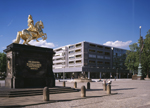
Interview

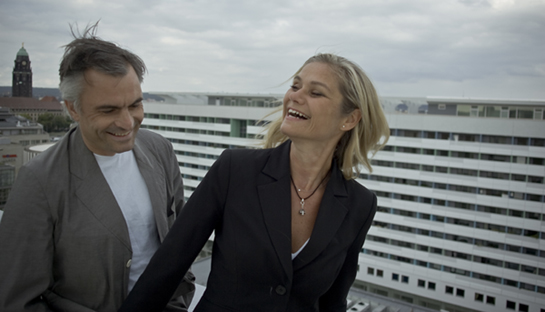
Ms. Lang, Mr. Knerer, how did you come up with the idea of moving from Munich to Dresden?
Knerer: It was chance. Back then, in the early 90s, we had the impression that there was a lot to do here. Not that we were the only ones. There are several studios whose owners moved here after graduation in order to get things moving.
And was there a lot to do back then?
Knerer: More than the studios based in Dresden were able to cope with. That was our good fortune. Things even went as far as a colleague that had been invited to take part in a competition giving his invitation to us younger colleagues. Nobody would even think of doing that today. Together with Peter Kulka’s studio we got one of the two top prizes. We were really proud of that.
What was the competition to do with?
Knerer: The realignment in terms of urban development on Hauptstrasse on the perimeter of the new town and 1970s prefabricated concrete buildings. The building fabric was extremely dilapidated. Something needed to be done quickly. In the competition we and the Kulka studio had favored keeping the buildings. The real estate company Woba though it was a good idea.
As a result you spent several years refurbishing old prefabricated concrete buildings on Hauptstrasse step by step. It made you well-known.
Lang: Not quite. Other studios were responsible for some sections on Hauptstrasse.
But you are regarded as the ‘Woba’ architects in Dresden.
Knerer: Totally wrong. Thanks to Woba the residential buildings we completed were several projects that frequently received public attention, and some of which were awarded prizes. This has been the lasting impression. However, we have no intention of confining ourselves to residential buildings alone. Though we are extremely familiar with prefabricated concrete buildings and enjoy working on them we are nonetheless planning a whole raft of other things: the Center for Energy Technology in Dresden, for example, and a cooling facility in Chemnitz.
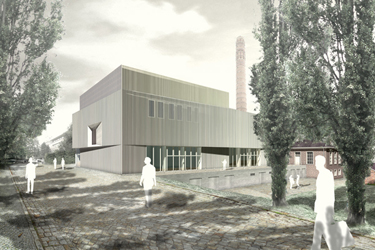
Lang: We are primarily interested in are spaces, whether they are used for living in or other purposes. We actively go out in search of challenges and take part in a lot of competitions.
How many did you enter last year?
Lang: About six, of which three were really major ones. It is an important aspect of our work, and gives us an opportunity to address all manner of themes. It’s a luxury we do not want to do without.
How would you describe your architecture?
Knerer: We try to limit the number of elements that have a design impact to two, at most three, so as to create readily accessible structures.
Lang: Many people say we produce straight, cool things.
Do you have any role models?
Knerer: We don’t imitate anyone. We always attempt to get to the bottom of the assignment at hand in order to come up with the best solution.
Lang: We think Kulka is good, for example, because his buildings are minimalist and straightforward.
Knerer: Developing a formula that we use time and again is not our thing. There are several studios in which it is obvious where the owners or staff have worked before. This cannot be the case with us because we have not worked in well-known studios. We try to develop a style of our own.
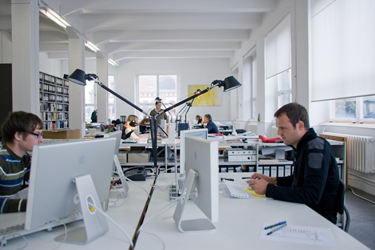
How do you divide the work up?
Knerer: We work together. Really. It’s totally irrelevant who has the idea; we discuss it and make a joint decision with regard to the best proposal.
Lang: Thomas is the visionary. I’m more of a realist.
Are you both involved in negotiations with developers?
Lang: Previously I used to get asked if my boss could come along too, as people assumed that Knerer and Lang were two men. That has all changed now. In Dresden there are now several studios that are also run by women. Perhaps this is something that is more commonplace than in the West.
And your staff?
Knerer: The team is of paramount importance. Our approach is for staff to be able to work on a project from beginning to end. That doesn’t always work, as the ones who come up with the good ideas are not always the right contact persons for the construction companies. Nobody who produces a design can be blasé about what it looks like in detail.
Models or renderings?
Knerer: We frequently also build big models, as with 3D drawings you sometimes reach limits. If it’s a case of winning over the developer or demonstrating what certain details look like, you just cannot beat models. On the PC we use programs that can be learned quickly and that are reliable. For one competition we had the problem of the PC not producing the various perspectives in time because the software used was too elaborate and our 3D models too complex. So that was weeks of work all for nothing.
How has the situation for architects in Dresden changed since 1993?
Lang: I was in Munich recently. The former royal stables at the court riding school of Leo von Klenze there have been put to new cultural use. All the politicians there are saying that Munich should portray itself as an open, future-oriented city. There is a wish not to limit possibilities. Dresden, on the other hand, is a reactionary place, it has to be said. The killer argument in building consultations is always: That’s just the way it looks. And then there’s the accusation that architects just want to realize themselves.
Knerer: You have to be able to substantiate architecture with pragmatic arguments. Fire protection and cost-effectiveness – that’s the way to get something through.

In your opinion what is all this about the inhabitants of Dresden being passionate about their city? There are heated arguments being conducted about the development of Neumarkt, by the Frauenkirche.
Knerer: For a long time now Neumarkt has not been about architecture, but rather about clichés. There are lots of people here who use the term baroque without actually knowing what it is. I have my difficulties with that. The fact that for many Dresden is a role model is also problematic. In the discussion about whether to rebuild its city palace, the Stadtschloss, Berlin, for example, quotes the very good example of the Frauenkirche in Dresden, even though the situation in each case is very different.
Lang: As an architect one problem you have with rebuilding something is that mostly it is anything but.
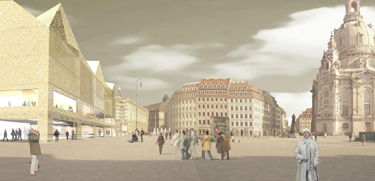
Knerer: In my opinion Neumarkt has nothing to do with architecture; it’s just a focal point, with which an attempt is being made to win back public confidence, which is being sought with regard to something that is supposedly good.
Have you become involved in the discussion?
Knerer: We were recently invited to a discussion about Neumarkt. After all, we had won a prize in the competition for rebuilding the Gewandhaus. Without wanting to go into any great detail about how representatives of those in favor of reconstruction behave there, this is not the sort of discussion you really want to become part of.
For whom would you never build something?
Lang: In the past we have turned down contracts because there was something suspicious about somebody. On the other hand, however, we have become so fond of several of our developers that they have become our best friends.
Knerer: We meet them frequently.
At the developers’ cook-ups, which you initiated, for example?
Knerer: Indeed, we thought we would throw a big party with all the developers; they ought to get on well with each other, after all they have got something in common.
Did you cook for them all?
Lang: We select the recipes and do the shopping. For several courses. Groups of 5 to 6 people then meet.

Was it a success?
Knerer: When you throw a party for people who don’t know each other, they are initially shy of each other and don’t know what to talk about.
Lang: For this reason we put the names of our guests in a hat and drew lots to see who would cook with whom. The first time a few wanted to swap, but we just ignored them. After all, it’s all about getting to know each other. It worked brilliantly.
Did you lend any new contracts on the back of it?
Knerer: That wasn’t what it was about. We aim to demonstrate that we still have interest in the project afterwards, that we get on well with the developers and that there is no reason to be worried about working with architects. There are lots of people here who build a house but would never dream of hiring an architect. Here hiring architects for building a house is unfortunately still regarded as a luxury.
What arguments do you use to win over interested private developers?
Lang: We don’t aim to win them over at any price. Possible collaboration also has a lot to do with liking someone and above all with trust.
Thank you very much for the interview.












































